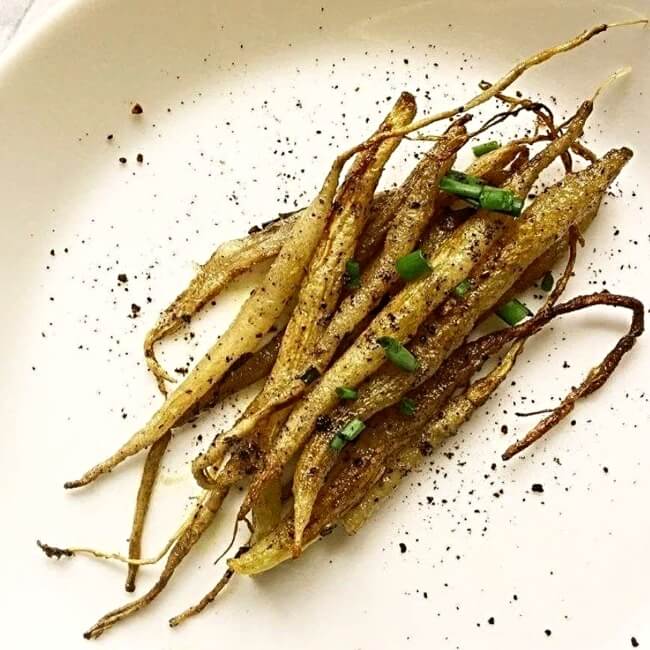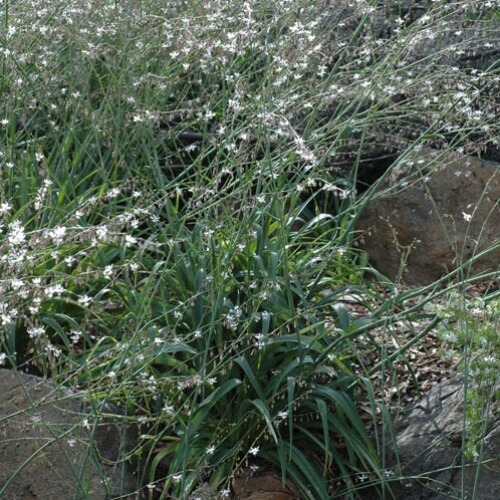The scent of vanilla feels both exotic and familiar. It makes me think of summer days, ice cream scoops and puddings, but also candles and winter comfort.
Vanilla lily is an Australian native that delights the senses, in smell, taste, and look. This guide covers an introduction to Arthropodium milleflorum, how to propagate the plant using seeds, care advice, and a guide on harvesting and enjoying the tuberous roots.
More...
Family: | Asparagaceae |
|---|---|
Genus: | Arthropodium |
Species: | A. milleflorum |
Origin: | Australia |
Common Names: | Vanilla lily, Pale vanilla lily |
Location: | Indoor and outdoor |
Type: | Clumping perennial |
Growth: | Up to 1 metre tall with 40 cm spread |
Sun requirements: | Full sun, partial shade, full shade |
Foliage Colour: | Green |
Flower Colour: | White, Blue, Pink |
Flowering: | Spring, summer |
Edible Parts: | Roots and flowers |
Maintenance level: | Low |
Poisonous for pets: | No |
Introduction to Vanilla lily
I love a low maintenance plant. I also love plants with flowers that smell good. The vanilla lily is both of these things. Flowers filled with vanilla fragrance arrive at the end of spring and into summer, and these beauties are either white, or a light shade of pink or blue.
Now that you can picture the beauty of Arthropodium milleflorum, let’s get onto what makes it low maintenance. The plant will grow and produce flowers in sun or in shade and is shaped like grass. It can handle both drought and frost, and even heavy shade is no match for the pale vanilla lily.
Arthropodium milleflorum has edible roots which were enjoyed by indigenous people, either raw or roasted. As an Australian native, it lives in forest and grasslands in Queensland, southern Australia, and Tasmania.
How to Grow Vanilla Lily
Growing a few vanilla lily plants together in your garden can make for a lovely visual effect. Sandy or clay soil is fine, but the ultimate recipe for happy growth would be a loamy soil, with partial sunlight and lots of water. Vanilla lily will also grow in a medium sized pot.

Source: Yarra Ranges Council
Propagating Arthropodium milleflorum
Arthropodium milleflorum can be easily propagated from seed. Australian native seeds can be planted throughout the year. The best chance of success though would be to sow seeds during autumn and spring. Use well-draining pots or seed trays and use a native potting mix from your local nursery.
The best temperature for germination is between 18-22°C. Be careful not to overwater the seeds. When the planted seedlings produce their second set of leaves, they are ready for larger pots and can be planted in the garden after about 3 months.
Pre-treating vanilla lily seeds before planting them can help with successful germination or speed up the process. It isn’t a must though. If pre-treating the seeds, use a smoke treatment process. This can be done in two ways.
One method is to sprinkle vermiculite over the potting mix once the seeds are planted. When the soil is watered, the compounds are able to work into the soil. Another method is to add a teaspoon of vermiculite to a jar of water.
Shake the mix and then let it stand for 30 minutes. Drain the mix and keep the water. Soak the seeds in the strained water for 8 to 12 hours and then plant them.
Be sure to transplant germinated seedlings before they become root bound in the planting pots. Try your best not to disrupt the roots too much. This will help them get going again in the new container. Vanilla lily seedlings will need regular water while they are young and growing.


Get Your Free Guide:
Master Growing Australian Natives eBook
A Must Have Complete Guide for Every Australian Garden
Get Your Free Guide:
Master Growing Australian Natives eBook
A Must Have Complete Guide for Every Australian Garden
How to Care for Vanilla Lily
- Sunlight - Arthropodium milleflorum is versatile with lighting needs. They can grow in full sun, partial shade, and even heavy shade.
- Soil - Pale vanilla lily needs a pH level that is acid or neutral. Soil type can be loam, sandy loam, or clay loam. The plant is easy with moisture needs. Soil can be dry or well-draining, or somewhere in-between.
- Water - Under watering your vanilla lily might encourage the plant to become dormant. Give your plant less water during the colder months.
- Pruning - Flower stems that are dry can be pruned off the plant at the base. Collect seeds at the same time if needed.
- Fertilise - Potting soils usually contain enough nutrients for new plant growth. When your pale vanilla lily has used these up, it will probably need to be transplanted into a bigger pot.
Repot your plant when it has doubled in size, or once a year. Your plant won’t need fertiliser until the seedlings are quite big. When you do fertilise, just use a small bit of slow release fertiliser, or you can top dress the soil with about 5 cm of compost.
Vanilla Lily Bush Tucker Guide
The roots of vanilla lily are delicious. They have a slightly sweet flavour and taste best when they are still young. The roots tend to become bitter when they’re older. I can happily munch on vanilla lily tubers that have just come straight out of the ground.
The roots are just as tasty if I roast them lightly and add a bit of salt and oil, or slice them up and pop in the air fryer. Pale vanilla lily flowers are also edible. I enjoy using them as a garnish on my salads but they would look just as lovely on a cake.

Source: Melbourne Bushfood
Harvesting Vanilla Lily Tubers
It can take up to 2 years before you get to harvest any tubers but I would say it’s worth the wait! When the plant is mature, you can harvest tubers any time you like. The ideal time though would be at the end of the growing season, which is also the end of spring.
Harvesting is simple. Dig up the whole vanilla lily plant and harvest the roots you need. Use them like potatoes which you can mash, roast, or boil. Remember to clean the tubers well before you cook them.
Plants that are not harvested will go dormant over summer, and then make an appearance with new shoots in autumn.
Vanilla Lily Pests and Diseases
Arthropodium milleflorum doesn’t officially have any particular pests or diseases. There are however a few that are common to Australian native plants that could affect your vanilla lily at some stage.
Scale
Sap suckers is the most appropriate name for scale I think. These insects have a hard or waxy shell and can torment a plant when the colonies are big enough. Younger vanilla lily plants suffer the most because their stems are softer.
Scale can be difficult to see on a plant but there are other signs to look out for. A big colony of ants hanging around on the stems and branches of the plant are a giveaway. They actually protect the scale and enjoy their sugary secretions.
An established plant can usually handle scale quite well, but if the plant is wilting or is dropping leaves, treatment is necessary. Spraying the plant with neem oil is an effective organic and natural treatment.
Psyllids
Another breed of sap suckers, psyllids look like pimples on the leaves. They can damage new plant growth and like to operate from the start of spring to the middle of autumn. Prune foliage that is under attack and treat with neem oil as you would with scale.
Myrtle Rust
Symptoms of myrtle rust include red and purple colouring on the leaves. There are also bright yellow bumps on new plant growth. The disease makes leaves look distorted and then kills them off.
Things that can help are removing infected leaves, not watering overhead on top of the leaves, and making sure there is good circulation around the plant. Neem oil or a baking soda spray work well for treatment.
Sooty Mould
Sooty mould is usually caused by sap sucking pests. It’s a black fungus which lives off the sugar secretions from scale and aphids, starting on the newer growth of a plant and then spreads to other parts.
A plant will start to look unhealthy as it struggles to maintain wellbeing. A great treatment is creating a spray with water and dishwashing liquid. Spray the plant well, leave for 15 minutes, and then rinse off with a strong spray of water.
Root rot
A lot of native Australian plants come from areas where they are used to growing in sandy soil. This kind of soil can drain well after rain. In a home garden, a plant like the vanilla lily might grow in a clay soil and then roots then stay wet for a longer time.
If there isn’t good drainage, root rot can happen. Signs of root rot include yellow leaves that are wilting and have dieback. Roots will need to be cleaned, pruned, and the plant placed in fresh soil that has better drainage.
Frequently Asked Questions About Vanilla Lily

Source: Bungalook Nursery
Can I grow a vanilla lily indoors?
Yes you can. If you plant to harvest the roots for eating, use a medium size pot to allow the tubers space to grow. Put the pot near a sunny window and don’t overwater it.
What does the name Arthropodium milleflorum mean?
Arthropodium comes from the Greek word ‘arthron’ which means ‘joint’ and ‘podion’ means ‘a small foot’. Milleflorum comes from the Latin word ‘mille’ which means ‘one thousand’, and ‘florum’ which means ‘flowers’.
What is the ideal spacing for pale vanilla lily when planting a few together?
The plant forms clumps and becomes thick the older it gets. If you are planting a few vanilla lilies together, space each plant 50 cm apart.
When is the ideal time to collect vanilla lily seeds?
The middle to the end of summer.
How big do my seedlings need to be before transplanting?
Once they reach 10 cm in height, they are ready for transplanting.
I’ve seen the leaves of an Arthropodium milleflorum die back completely in summer. Does this mean it's dead?
This does happen to vanilla lily plants on occasion and sometimes the leaves disappear completely. The bulb is still alive under the soil, so don’t give up on your plant just yet.
Wrapping Up Our Guide to Growing Vanilla Lily in Your Garden
Vanilla lily is an impressive Australian groundcover. The silver to green leaves look like a clump of grass but are much softer. With stems reaching up to a metre high, pretty and perfumed flowers pop their heads out in spring, with the promise of a beautiful season to come.
Published on January 15, 2024 by Gary Clarke
Last Updated on October 22, 2024






Good morning Gary
I have just returned from a holiday in Australia and visited the botanical gardens in Melbourne and Sydney.
I would have liked to buy many plants but it is forbidden.
I wish I could try with the seeds of your plants. Do you know anyone willing to send them?
the companies contacted do not ship outside Australia
?
Hey Antonio,
Glad to hear you enjoyed Australia and our native flora so much.
What seeds in particular are you after?
You’re in Italy correct?
I will see what I can do.
Cheers,
Gary